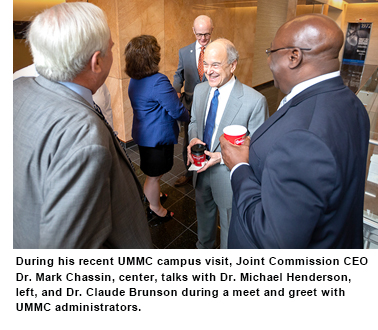Our Journey to High Reliability
Good morning!
Can you believe June has flown by so quickly?
 If you missed a special visitor on campus Monday, I’d like to give you a recap of his message. Our responsibility for quality care and safety for patients and staff alike was driven home by Dr. Mark Chassin, president and CEO of The Joint Commission, the nation’s leading health care organization accrediting agency. In his second visit to the Medical Center, Dr. Chassin reminded us of how and why we need to keep patients safe. He told us we’ve made progress in changing our culture and declaring quality our top strategic priority since he last visited in November 2015.
If you missed a special visitor on campus Monday, I’d like to give you a recap of his message. Our responsibility for quality care and safety for patients and staff alike was driven home by Dr. Mark Chassin, president and CEO of The Joint Commission, the nation’s leading health care organization accrediting agency. In his second visit to the Medical Center, Dr. Chassin reminded us of how and why we need to keep patients safe. He told us we’ve made progress in changing our culture and declaring quality our top strategic priority since he last visited in November 2015.
And he challenged us.
Of his work with The Joint Commission, he said, “We see routine safety processes failing routinely. We have this seeming avalanche of events that are impossible for patients and families to understand. There aren’t any words that are adequate.
“A commitment to get to zero harm . . . That’s the heart of the message today.”
Through the work of physician leaders, including Dr. Michael Henderson and Dr. Charles O’Mara, along with leaders from other disciplines and staff at all levels, we have made much progress. And it doesn’t stop there. We aspire to be a high-reliability health care organization, which means consistently giving all patients high-quality, safe care. We will reach that gold standard through improving our efficiency, effectiveness, processes, customer satisfaction and culture.
Eliminating all patient harm events – not just the most egregious ones such as performing surgery on the wrong patient or the wrong site, dispensing incorrect medications that result in death, or irretrievably losing irreplaceable tissue specimens – is a lofty goal. Some might say it’s impossible and not worth chasing, or that our clinical providers won’t go along because they believe there will always be some degree of patient harm.
“If zero isn’t the right number, then how much patient harm is OK?” Chassin asked. “The only acceptable answer is zero, and the only acceptable question is, ‘How long will it take us to get there?’”
We’re not there, but engaged leadership and front-line staff are making measurable steps toward reaching a goal that isn’t a fantasy. The Medical Center in March kicked off “Chasing Zero,” a Joint Commission-inspired initiative that strives to eliminate serious safety events impacting patients and to cultivate safer, more effective care. Want to know how long it’s been since we’ve had one of six specific serious safety events? It’s at the top of the Clinical Intranet. As of 9 o'clock this morning, it was 8 days, 21 hours, 0 minutes and 40 seconds.
If you want to know where we stand on patient harm, mortality and customer satisfaction, even specific to a hospital floor, browse the safety/quality scorecard on the Clinical Intranet. The public also can see those high-level statistics by visiting the Clinical Quality program pages on the Medical Center’s website. That’s part of our journey to being accountable to patients and to ourselves.
If you see a harm event or the risk of one, or if you see an unsafe condition such as a slippery floor or an obstructed exit, please report it using the I-Care Report icon found on the desktop of most UMMC computers. If we don’t acknowledge our errors and processes that can leave patients at risk, we can’t learn from them and keep them from re-occurring.
We won’t get to zero harm by a blame game, although there are times when blame must be assigned for repeated violations of safety protocols or condescending behaviors that undermine a culture of safety. We won’t get there with a project, or a series of projects, or a task force alone. It’s much harder than that. What’s needed, Dr. Chassin says, is a desire for robust process improvement, a systematic and proven approach to solving complicated problems.
We want to get to the point where zero harm is, as Dr. Chassin puts it, “the natural byproduct of the way we take care of patients.” It will take all of us to achieve this, whether we’re in clinical or non-clinical positions. Our culture of safety is changing. We must not lose that momentum.
I’m so proud to be part of an organization that treats the sickest of the sick and provides one-of-a-kind, compassionate care found nowhere else in Mississippi. We owe our patients - and ourselves - the highest quality of care. Let’s stay focused on our journey to zero patient harm as we strive, every day, to create A Healthier Mississippi.



